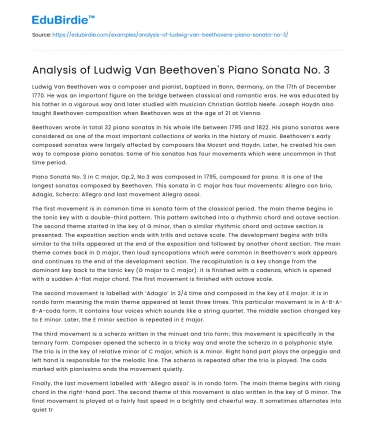Ludwig Van Beethoven was a composer and pianist, baptized in Bonn, Germany, on the 17th of December 1770. He was an important figure on the bridge between classical and romantic eras. He was educated by his father in a vigorous way and later studied with musician Christian Gottlob Neefe. Joseph Haydn also taught Beethoven composition when Beethoven was at the age of 21 at Vienna.
Beethoven wrote in total 32 piano sonatas in his whole life between 1795 and 1822. His piano sonatas were considered as one of the most important collections of works in the history of music. Beethoven’s early composed sonatas were largely affected by composers like Mozart and Haydn. Later, he created his own way to compose piano sonatas. Some of his sonatas has four movements which were uncommon in that time period.
Save your time!
We can take care of your essay
- Proper editing and formatting
- Free revision, title page, and bibliography
- Flexible prices and money-back guarantee
Piano Sonata No. 3 in C major, Op.2, No.3 was composed in 1795, composed for piano. It is one of the longest sonatas composed by Beethoven. This sonata in C major has four movements: Allegro con brio, Adagio, Scherzo: Allegro and last movement Allegro assai.
The first movement is in common time in sonata form of the classical period. The main theme begins in the tonic key with a double-third pattern. This pattern switched into a rhythmic chord and octave section. The second theme started in the key of G minor, then a similar rhythmic chord and octave section is presented. The exposition section ends with trills and octave scale. The development begins with trills similar to the trills appeared at the end of the exposition and followed by another chord section. The main theme comes back in D major, then loud syncopations which were common in Beethoven’s work appears and continues to the end of the development section. The recapitulation is a key change from the dominant key back to the tonic key (G major to C major). It is finished with a cadenza, which is opened with a sudden A-flat major chord. The first movement is finished with octave scale.
The second movement is labelled with ‘Adagio’ in 2/4 time and composed in the key of E major. It is in rondo form meaning the main theme appeared at least three times. This particular movement is in A-B-A-B-A-coda form. It contains four voices which sounds like a string quartet. The middle section changed key to E minor. Later, the E minor section is repeated in E major.
The third movement is a scherzo written in the minuet and trio form; this movement is specifically in the ternary form. Composer opened the scherzo in a tricky way and wrote the scherzo in a polyphonic style. The trio is in the key of relative minor of C major, which is A minor. Right hand part plays the arpeggio and left hand is responsible for the melodic line. The scherzo is repeated after the trio is played. The coda marked with pianissimo ends the movement quietly.
Finally, the last movement labelled with ‘Allegro assai’ is in rondo form. The main theme begins with rising chord in the right-hand part. The second theme of this movement is also written in the key of G minor. The final movement is played at a fairly fast speed in a brightly and cheerful way. It sometimes alternates into quiet trills and silences. The movement ends with spirited chords.






 Stuck on your essay?
Stuck on your essay?

